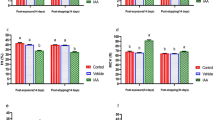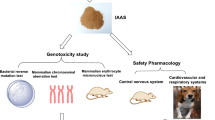Abstract
SD-2007 is a new derivative of apicidin, an anti-parasitic agent and a histone deacetylase (HDAC) inhibitor. A subacute toxicological evaluation of SD-2007 was investigated for 2 weeks in ICR mice. After oral administration of SD-2007 (0, 0.2, 1, 5 or 25 mg/mouse), the clinical signs, mortalities, body weight changes, blood biochemical parameters, absolute and relative organ weights were examined. One day after the administration of SD-2007, excretion of soft feces in 1 and 5 mg/head groups, and one male in 25 mg/mouse group developed diarrhea, but theses complications were disappeared two days after administration. No mortalities were observed in animals up to 25 mg/mouse (LD50, >25 mg/kg), but absolute and relative weights of testes were significantly lower at the highest dose group (25 mg/mouse) and serum LDH and glucose levels were elevated in male mice. In addition, alanine aminotransferase (ALT), aspartate aminotransferase (AST), and alkaline phosphatase (ALP) activities were reduced in female mice at all dosages. These data suggest that SD- 2007 may be sex specific and be toxic to the male reproductive organ, and thus our findings require further investigation and in particular chronic toxicological investigations should be investigated.
Similar content being viewed by others
References
Ahn, M. Y., Lee, J., Na, Y. J., Choi, W. S., Lee, B. M., Kang, K. W., and Kim, H. S., Mechanism of apicidin-induced cell cycle arrest and apoptosis in Ishikawa human endometrial cancer cells. Chem. Biol. Interact., 179, 169–177 (2009a).
Ahn, M. Y., Na, Y. J., Lee, J. W., Lee, B. M., and Kim, H. S., Apicidin induces apoptosis via cytochrome c-mediated intrinsic pathway in human ovarian cancer cells. Biomolecules & Therapeutics, 17, 17–24 (2009b).
Cheong, J. W., Chong, S. Y., Kim, J. Y., Eom, J. I., Jeung, H. K., Maeng, H. Y., Lee, S. T., and Min, Y. H., Induction of apoptosis by apicidin, a histone deacetylase inhibitor, via the activation of mitochondria-dependent caspase cascades in human Bcr-Abl-positive leukemia cells. Clin. Cancer Res., 9, 5018–5027 (2003).
Darkin-Rattray, S. J., Gurnett, A. M., Myers, R. W., Dulski, P. M., Crumley, T. M., Allocco, J. J., Cannova, C., Meinke, P. T., Colletti, S. L., Bednarek, M. A., Singh, S. B., Goetz, M. A., Dombrowski, A. W., Polishook, J. D., and Schmatz, D. M., Apicidin: a novel anti-protozoal agent that inhibits parasite histone deacetylase. Proc. Natl. Acad. Sci. U.S.A., 93, 13143–13147 (1996).
Di Renzo, F., Broccia, M. L., Giavini, E., and Menegola, E., Relationship between embryonic histonic hyperacetylation and axial skeletal defects in mouse exposed to the three HDAC inhibitors apicidin, MS-275, and sodium butyrate. Toxicol. Sci., 98, 582–588 (2007).
Di Renzo, F., Corsini, E., Broccia, M. L., Marinovich, M., Galli, C. L., Giavini, E., and Menegola, E., Molecular mechanism of teratogenic effects induced by the fungicide triadimefon: study of the expression of TGF-beta mRNA and TGF-beta and CRABPI proteins during rat in vitro development. Toxicol. Appl. Pharmacol., 234, 107–116 (2008).
Gallo, P., Latronico, M. V., Gallo, P., Grimaldi, S., Borgia, F., Todaro, M., Jones, P., Gallinari, P., De Francesco, R., Ciliberto, G., Steinkühler, C., Esposito, G., and Condorelli, G., Inhibition of class I histone deacetylase with an apicidin derivative prevents cardiac hypertrophy and failure. Cardiovasc. Res., 80, 416–424 (2008).
Gámez, R., Mas, R., Noa, M., Menéndez, R., Alemán, C., Acosta, P., García, H., Hernández, C., Amor, A., Pérez, J., and Goicochea, E., Acute and oral subchronic toxicity of D-003 in rats. Toxicol. Lett., 118, 31–41 (2000).
Gaymes, T. J., Padua, R. A., Pla, M., Orr, S., Omidvar, N., Chomienne, C., Mufti, G. J., and Rassool, F. V., Histone deacetylase inhibitors (HDI) cause DNA damage in leukemia cells: a mechanism for leukemia-specific HDIdependent apoptosis? Mol. Cancer Res., 4, 563–573 (2006).
Han, J. W., Ahn, S. H., Kim, Y. K., Bae, G. U., Yoon, J. W., Hong, S., Lee, H. Y., Lee, Y. W., and Lee, H. W., Activation of p21(WAF1/Cip1) transcription through Sp1 sites by histone deacetylase inhibitor apicidin: involvement of protein kinase C. J. Biol. Chem., 276, 42084–42090 (2001).
Han, J. W., Ahn, S. H., Park, S. H., Wang, S. Y., Bae, G. U., Seo, D. W., Kwon, H. K., Hong, S., Lee, H. Y., Lee, Y. W., and Lee, H. W., Apicidin, a histone deacetylase inhibitor, inhibits proliferation of tumor cells via induction of p21WAF1/Cip1 and gelsolin. Cancer Res., 60, 6068–6074 (2000).
Hong, J., Ishihara, K., Yamaki, K., Hiraizumi, K., Ohno, T., Ahn, J. W., Zee, O. P., and Ohuchi, K., Apicidin, a histone deacetylase inhibitor, induces differentiation of HL-60 cells. Cancer Lett., 189, 197–206 (2003).
Im, J. Y., Park, H. R., Kang, K. W., Choi, W. S., and Kim, H. S., Modulation of cell cycles and apoptosis by apicidin in estrogen receptor (ER)-positive and-negative human breast cancer cells. Chem. Biol. Interact., 172, 235–244 (2008).
Itazaki, H., Nagashima, K., Sugita, K., Yoshida, H., Kawamura, Y., Yasuda, Y., Matsumoto, K., Ishii, K., Uotani, N., Nakai, H., Terui, A., Yoshimatsu, S., Ikenishi, Y., and Nakagawa, Y., Isolation and structural elucidation of new cyclotetrapeptides, trapoxins A and B, having detransformation activities as anti-tumor agents. J. Antibiot., 43, 1524–1532 (1990).
Kim, H. S., Lee, S. K., Kim, K. B., Kwack, S. J., Ahn, M. Y., Choi, B. C., and Lee, B. M., Acute Oral Toxicity of KDRD-002 in Rats. J. Appl. Pharmacol., 4, 310–313 (1996).
Kim, H. S., Park, S. M., Kim, Y. K., Byun, S. H., Yun, J. D., Yu, Y. H., Lee, H. W., and Lee, B. M., Acute Toxicity of DWH-01(Ranitidine:Bithmuth Subcitrate: Sucralfate) in Rats. J. Appl. Pharmacol., 2, 262–265 (1993).
Kim, M. S., Son, M. W., Kim, W. B., Park, Y. I., Moon, A., Apicidin, an inhibitor of histone deacetylase, prevents H ras-induced invasive phenotype. Cancer Lett., 57, 23–30 (2000).
Kim, Y. K., Lee, E. K., Kang, J. K., Kim, J. A., You, J. S., Park, J. H., Seo, D. W., Hwang, J. W., Kim, S. N., Lee, H. Y., Lee, H. W., and Han, J. W. Activation of NF-kappaB by HDAC inhibitor apicidin through Sp1-dependent de novo protein synthesis: its implication for resistance to apoptosis. Cell Death Differ., 13, 2033–2041 (2006).
Kwack, S. J., Chun, S. A., Lim, S. Y., Park, H. S., Hong, C. Y., Kim, W. B., Kim, B. M., Ahn, B. O., and Lee, B. M., Acute toxicity study of recombinant human erythropoietin (rHu-EPO) in Rats. J. Appl. Pharmacol., 4, 330–333 (1996a).
Kwack, S. J., Kim, H. S., Chun, S. A., Lim, S. Y., Park, H. S., Hong, C. Y., Han, H. S., Choi, B. C., and Lee, B. M., Comparative acute toxicity studies on Woo Whang Chung Sim Won Suspension and Pill in Mice, Kor. J. Toxicol., 12, 295–303 (1996b).
Kwon, S. H., Ahn, S. H., Kim, Y. K., Bae, G. U., Yoon, J. W., Hong, S., Lee, H. Y., Lee, Y. W., Lee, H. W., and Han, J. W., Apicidin, a histone deacetylase inhibitor, induces apoptosis and Fas/Fas ligand expression in human acute promyelocytic leukemia cells. J. Biol. Chem., 277, 2073–2080 (2002).
Landsdown, A. B., Experimental Toxicology, the Basic Issues, BIBRA, Surrey, (1993).
Long, G., Symanowski, T., and Roback, K., Precision in data acquisition and reporting of organ weight in rats and mice, Toxocol. Pathol., 26, 316–318 (1998).
Lorke, D., A new approach to practical toxicity testing. Arch. Toxicol., 54, 275–287 (1983).
Menegola, E., Di Renzo, F., Broccia, M. L., Prudenziati, M., Minucci, S., Massa, V., and Giavini, E., Inhibition of histone deacetylase activity on specific embryonic tissues as a new mechanism for teratogenicity, Birth Defects Res. B. Dev. Reprod. Toxicol., 74, 392–398 (2006).
Park, J. S., Lee, K. R., Kim, J. C., Lim, S. H., Seo, J.A., Lee, Y. W., A hemorrhagic factor (Apicidin) produced by toxic Fusarium isolates from soybean seeds, Appl. Environ. Microbiol., 65, 126–130 (1999).
Piyachaturawat, P., Tubtim, C., Chuncharunee, A., Komaratat, P., and Suksamrarn, A., Evaluation of the acute and subacute toxicity of a choleretic phloracetophenone in experimental animals. Toxicol. Lett., 129, 123–132 (2002).
Rehg, J. E. and Toth, L. A., Rodent quarantine programs: purpose, principles and practice, Lab. Animal Sci., 48, 438–447 (1998).
Schlede, E., Mischke, U., Diener, W., and Kayser, D., The international validation study of the acute toxic class method (oral). Arch. Toxicol., 69, 659–670 (1995).
Singh, S. B., Zink, D. L., Liesch, J. M., Mosley, R. T., Dombrososki, A. W., Bills, G. F., Darkin-Rattray, S. J., Schmatz, D. M. and Goetz, M. A., Structure and chemistry of apicidins, a class of novel cyclic tetrapeptides without a terminal alpa-keto epoxide as inhibitors of histone deacetylase with potent antiprotozoal activities. J. Org. Chem., 67, 815–825 (2002).
Singh, S. B., Zink, D. L., Polishook, J. D., Dombrososki, A. W., Darkin-Rattray, S. J., Schmatz, D. M., and Goetz, M. A., Apicidins: novel cyclic tetrapeptides as coccidiostats and anti-malarial agents from Fusarium pallidoroseum, Tetrahedron Lett., 37, 8077–8080 (1996).
Ueda, T., Takai, N., Nishida, M., Nasu, K., and Narahara, H., Apicidin, a novel histone deacetylase inhibitor, has profound anti-growth activity in human endometrial and ovarian cancer cells. Int. J. Mol. Med., 19, 301–308 (2007).
Yoo, E. J. and Lee, B. M., Comparative mutagenicity for apicidin and apicidin derivatives (SD-0203 and SD-2007), histone deacetylase inhibitors. J. Toxicol. Environ. Health A., 68, 2097–2110 (2005).
You, J. S., Kang, J. K., Lee, E. K., Lee, J. C., Lee, S. H., Jeon, Y. J., Koh, D. H., Ahn, S. H., Seo, D. W., Lee, H. Y., Cho, E. J., and Han, J. W. Histone deacetylase inhibitor apicidin downregulates DNA methyltransferase 1 expression and induces repressive histone modifications via recruitment of corepressor complex to promoter region in human cervix cancer cells. Oncogene, 27, 1376–1386 (2008).
Zbinden, G. and Flury-Roversi, M., Significance of the LD50 test for toxicological evaluation of chemical substance. Arch. Toxicol., 47, 77–99 (1981).
Author information
Authors and Affiliations
Corresponding author
Rights and permissions
About this article
Cite this article
Kwack, S.J., Kim, K.B. & Lee, B.M. Toxicological evaluation of an apicidin derivative, histone deacetylase inhibitor SD-2007 in mice. Arch. Pharm. Res. 32, 789–797 (2009). https://doi.org/10.1007/s12272-009-1519-0
Received:
Revised:
Accepted:
Published:
Issue Date:
DOI: https://doi.org/10.1007/s12272-009-1519-0




